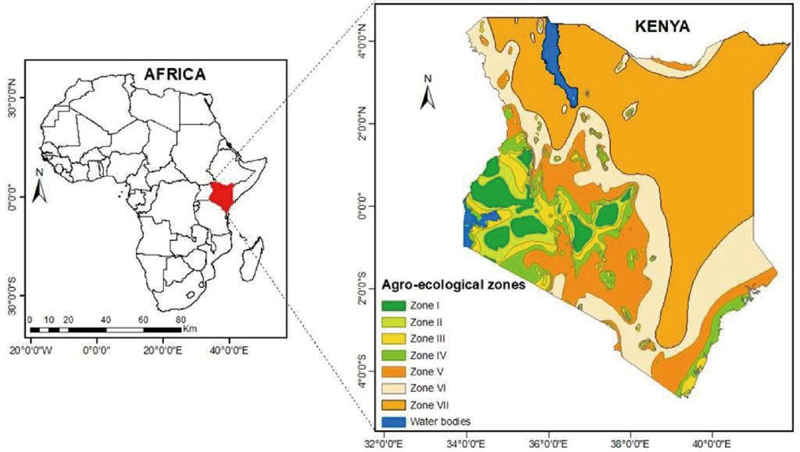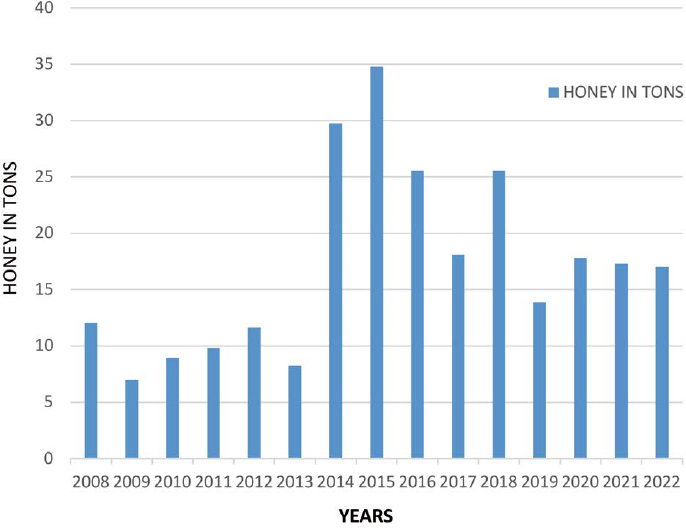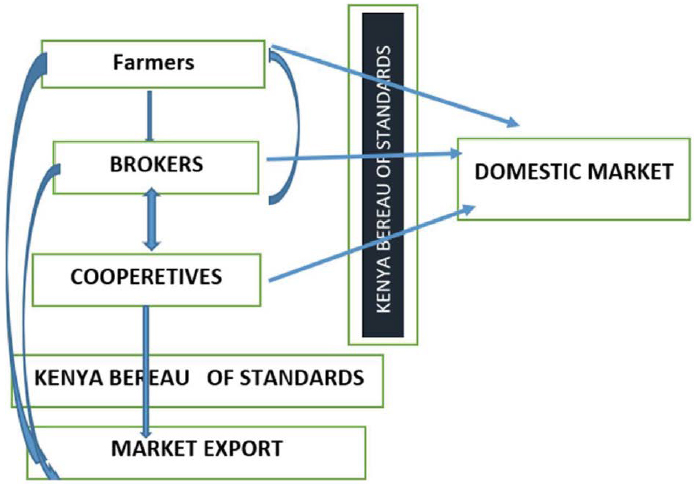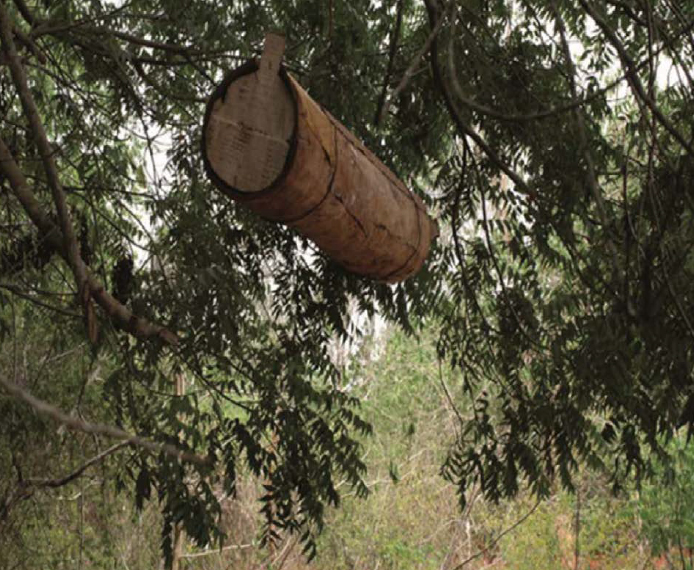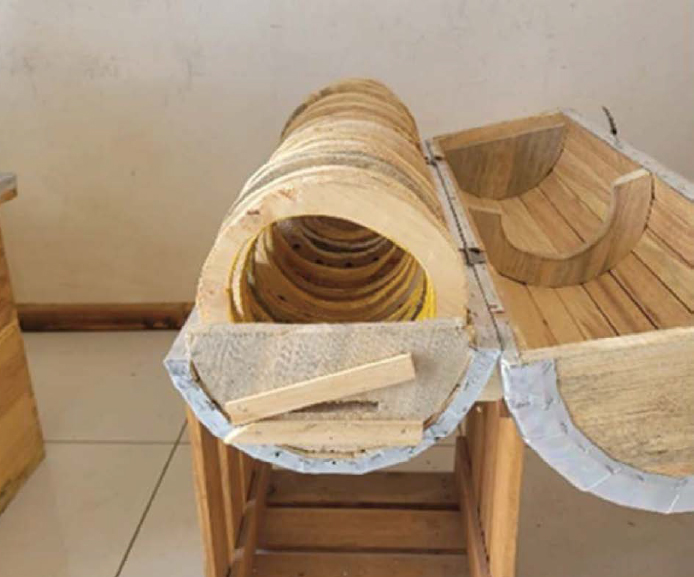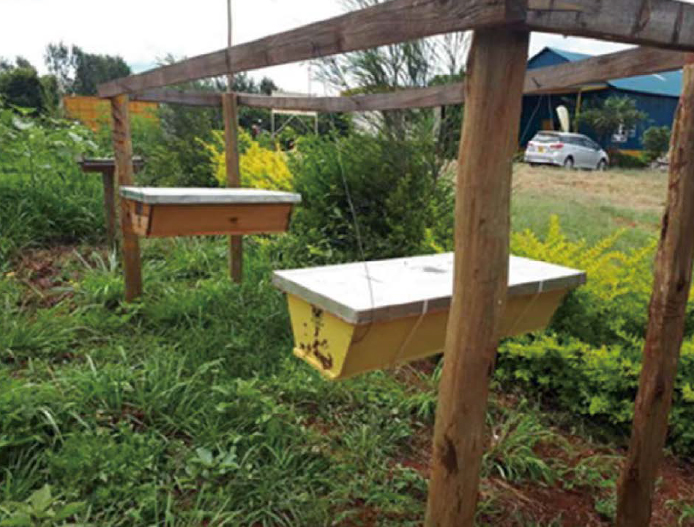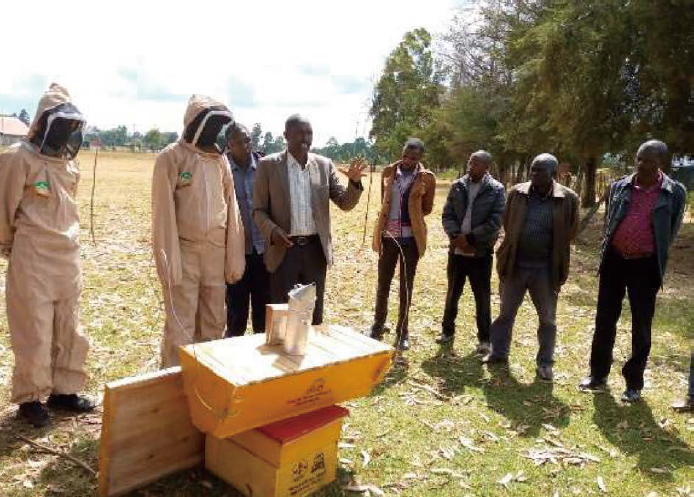
Case Studies for Honeybee Breeding Research: Beekeeping Status in Kenya
Abstract
Beekeeping has a long history in Kenya, where bees were hunted for honey which was valued as food and as dowry during customary marriages. Modern bee keeping was introduced by colonial government in the 1950s, further promoted by government and other development actors after independence. In Kenya beekeeping is regarded in public policy as a minor economic sub-sector and as such is positioned alongside livestock development policy. The Apiculture (beekeeping) and Emerging Livestock Division is located within the Kenyan Ministry of Livestock. Two methods of beekeeping are mostly practiced traditional and modern beekeeping. Traditional method is more popular compared to the latter. Beekeepers often organize themselves through beekeeping groups at local level but Kenya has no active national beekeeping organization. The current industry is characterized by individual companies that promote and sell modern equipment and services to beekeepers. Some of the companies go to extra mile to engage the interested farmers to contract farming. The Kenyan Government recognizes important role the beekeeping plays in the ASALS thus advocating it as an alternative source of livelihood the communities.
Keywords:
Kenya, Arid and semi-arid lands (ASALs), Honey bees, BeekeepingINTRODUCTION
Beekeeping is the art of managing bees in order to produce honey and bee wax, among other products. It produces high-quality food, enhance seed production through pollination, and protects the natural environment (Klein et al., 2007). Beekeeping requires little capital, little space, and no good soil, making it feasible to practise alongside other farm activities. It can be done by both men and women, and it is an appropriate activity for women̓s and youth groups, among others. Beekeeping is emerging as a highly successful agricultural practice for rural areas in developing countries due to its numerous economic benefits (Kukonza, 2009).
The Kenyan government, in its strategy for development of apiculture and emerging livestock, has identified honey production as one of the few ways by which people in the Arid and semi-arid (ASAL) areas to earn an income and better adapt to climate change without damaging the environment on which they rely for survival. The beekeeping industry contributes to the overall rural economy through trade (Paterson, 2006). According to Kasina et al. (2009), honey bees and other pollinators provide ecosystem services worth US$3.2 million to several major vegetable, fruit, and nut crops in western Kenya alone. Kenya̓s livestock subsector, which includes bees, accounts for approximately 10% of the country̓s GDP. Beekeeping alone contributes approximately 1.89% of this amount (Muya, 2004). Traditional beekeeping in Kenya requires little financial or labour input. It is a versatile and gender-friendly business that does not compete for resources like land with other agricultural activities. Beekeeping is viable in Kenyan arid regions and areas where other crops have failed (Bradbear, 2002).
The effort to improve Kenyan apiculture began in 1967 through an Oxfam grant that funded their very first beekeeping development project. In 1970 the Kenyan government, with financial and technical assistance from the Canadian government, established a new agriculture sector (The National Beekeeping Station) within the Kenyan Ministry of Agriculture. The new branch would pursue the development of Kenyan beekeeping through extension services, research development and the professional training for Kenyan beekeepers (Kigatiira, 1976) where Kenyans were introduced to western beekeeping technology and knowledge. Current development trends emphasise on the improvement of hive technology and bee management training as the primary approach. The country is Africa̓s fourth-largest honey producer. Kenya̓s potential for apiculture development is estimated to be more than 100,000 tonnes of honey and 10,000 tonnes of beeswax annually. At the moment, only about a fifth of this potential is being realised. 80% of Kenya is made up of arid and semi-arid lands (ASALs), which have a high potential for honey production, and apiculture is a major occupation in these areas due to the abundance of bee flora. Non-ASAL regions also practise beekeeping. However, adoption of modern beekeeping equipment and practices has been slow, owing to the high cost. The document describes beekeepers̓ production systems, the honey value chain, the common bee species found in Kenya, and their characteristics, as well as the importance, prospects, and challenges of Kenyan apiculture.
LOCATION AND POPULATION OF KENYA
Kenya is located in the East African region of Africa. Kenya shares borders with five other countries: Tanzania in the south, Uganda in the west, South Sudan in the north west, Ethiopia in the north, and Somalia in the east. Kenya̓s land area includes a wide variety of ecological zones (Fig. 1). The country has been divided into seven major agro-climatic zones based on moisture and temperature regimes, with attempts to further subdivide these zones. Jaetzold and Schmidt (1982/83) classified the country into agro-ecological zones based primarily on altitude and rainfall, which included humid, sub-humid, semi-humid and semi-arid, semi-arid, and very arid. About 80% of Kenya̓s terrestrial land is classified as arid to semi-arid. Rainfall here ranges from 150 to 750 mm per year. Temperatures in the ASAL are always high, consistently exceeding 30 Celsius. The high-potential areas, which cover 20% of the country, house approximately 75~80% of the national population. Beekeeping is a major economic activity in Kenya̓s arid and semi-arid lands (ASALs) which account for 80% of honey production. Non-ASAL areas also practise beekeeping. ASALs have a greater potential for producing honey and other hive products.
BEE FORAGE IN KENYA
Kenya has five agro-ecological zones, which are responsible for the wide variety of forage available. They are important in crop selection because they determine the crop̓s suitability in relation to the environmental conditions. Acacia species dominate bee foraging in Kenya̓s ASALS. The Kenyan highlands are distinguished by abundant rainfall, which supports a diverse range of crops and trees that serve as bee forage. This area produces multiflora honey (Table 1).
BEE HIVE POPULATION AND HONEY PRODUCTION
FAO (2020), estimated as of 2018, Kenya had a population of 1, 533, 668 beehives. The number of hives in Kenya has reduced by 16.76% for the last ten years. The number of hives in Kenya has decreased by 16.76% over the last ten years. There are no official estimates for Kenya̓s beekeeper population (Sagwa, 2021). Musinguzi et al. (2018) stated that the average number of beehives per beekeeper in Kenya is 15 hives. Honey is the primary hive product in Kenya. According to Carroll and Kinsella (2013), 96.7% of farmers sell only honey, with only 3.3% trading in other hive products such as beeswax, royal jelly, and live bees. According to Asiko et al. (2019), the average annual honey production in Kenya is 27,000 tonnes, contributing KES 7.43 billion to the GDP (Table 2). Other estimates place national honey production at 27, 557.3 tonnes (Kiptarus et al., 2011; Kiptarus and Asiko, 2014). According to the FAO (2020), Kenya produces 20,525 tonnes of honey per year (Fig. 2). The average honey production per hive per year ranges from 3.77 kg to 13.38 kg, depending on the type of hive. The counties with the highest honey production in 2014 were as follows: Nyandarua recorded 11,449,500 kilogrammes, followed by Tharaka Nithi with 1,382,029 kilogrammes. Kitui County reported more than 800,000 kilogrammes, and Baringo over 500,000 kilogrammes (KIPPRA, 2014).
HONEY MARKET IN KENYA
Kenya̓s honey market is considered unrestricted. Marketing is carried out by farmer groups, organizations, and brokers. Most of these organizations complete the apiculture value chain by processing and adding value to hive products. They also provide farmers with hives and other beekeeping equipment (Sagwa, 2021). Seven years ago, the standard farm-gate price of processed honey was $2.36 (Carroll and Kinsella, 2013), but it is now $7 per kg. The price depends on the type of honey (comb honey, processed honey, or crude honey) and the source. The Kenya Bureau of Standards (KEBS) controls the quality of honey. Apiary products must meet KEBS specifications. African honey standards (KS EAS 36: 2000) apply to all honey produced by honey bees and cover all honey presentation styles available for direct consumption. The Beeswax Standards (KS 1279: 2013) specify the minimum requirements and methods of testing for beeswax. KEBS, in particular, is in charge of promoting standardisation in industry and trade through standards development, conformity assessment, testing, and metrology (Sagwa, 2021). Kenya has a high demand for honey and is a net importer of it. This suggests that the potential for honey production in Kenya has not been fully exploited (Table 3).
BEE KEEPING SYSTEMS IN KENYA
Honey hunting was the beginning of humanity̓s long relationship with honeybees. To reduce the hardship and unpredictability of harvesting from wild colonies, people discovered ways to gain more control over bees by owning and managing colonies kept in hives. Beekeeping in Kenya is primarily practiced in areas where agricultural cropping opportunities are limited and the natural vegetation contains a diverse range of plant species suitable for bee foraging (Nightingale and Crane, 1976).
1. Traditional beekeeping system
Traditional beekeeping has a long history in Kenya, with numerous practices documented (Nightingale and Crane, 1983). Kenya is primarily a traditional beekeeping country, with approximately 10 million people practicing in arid and semi-arid regions (KNBS, 2021). The majority of beekeepers in Kenya still use traditional production systems, which primarily consist of hollow log hives (Cramb, 2003). These hives account for the single largest number of hive types in the country, estimated at 1,273,000, with 73% concentrated in the country̓s east (Mwabu et al., 2000). Other traditional hives include bark hives, which are made of peeled bark from a tree̓s trunk (Figs. 5, 6). Honey is typically harvested at night by climbing the trees from which the hives hang (Porter and Stern, 2002). The improved log hive from the traditional log combines traditional and modern hive technologies. It is made from a hollow wooden log that has been split lengthwise into two parts. The internal framework has wax rings that serve as a foundation for the bees to begin building honeycombs. In arid and semi-arid regions, hive occupancy ranges between 75~79%. It protects the bee from adverse weather conditions, particularly in the asals.
2. Transitional beekeeping
It is an intermediate beekeeping technique that falls between traditional and modern beekeeping. Top bar hives are classified into two types: Kenyan top bar hives and Tanzanian top bar hives. The hives can be constructed from wood or other readily available materials. Each hive contains 27~30 top bars to which honeybees attach their combs. The top bars measure 3.2 cm wide and 48.3 cm long, respectively. The hive is easily and quickly opened, the bees are guided to build parallel combs by following the line of the top bars, the top bars are easily removable, allowing beekeepers to work quickly, and honeycombs can be removed from the hive for harvesting without disturbing brood-containing combs (Hagoss, 2018). The top bar hives can be used to produce honey and wax as there is no recycling of combs.
3. Modern bee keeping
Modern beekeeping implies manipulating a bee colony based on some knowledge of the bees. This allows for much easier management and harvesting, resulting in higher yields and better honey quality. Langstroth hives are the most commonly used type (Fig. 7). Given the potential for beekeeping to generate income and alleviate poverty in rural areas, national governments, non-governmental organisations (NGOs), and international institutions have implemented apiculture development programs aimed at expanding the practice, modernising bee management, and increasing honey production. Despite the benefits described above, Langstroth is more expensive to purchase than log hives. Furthermore, much more technical and management expertise is required (Paterson, 2006). This has resulted in slow adoption of the technology among Kenyan beekeepers.
IDENTIFICATION AND CLASSIFICATION OF HONEYBEE SPECIES IN KENYA
In Kenya, honey bee identification is conducted through various field sampling methods. Proper preservation techniques, such as pinning and ethanol storage, are essential to maintain specimens for study. Curation of bee collections supports research on taxonomy and biodiversity, aiding in comparative analysis and species discovery (Reddy and Ronnanki, 2023). Africa and Madagascar are home to 11 bee subspecies of Apis mellifera (Engel, 1999; Franck et al., 2001). In Kenya, morphometric, allozyme, mitochondrial DNA and microsatellites methods have been used to identify bee subspecies. Three honey bee subspecies have been identified in Kenya: Apis mellifera monticola, Apis mellifera scutellata and Apis mellifera litorea (Smith, 1961; Engel, 1999; Wallberg et al., 2017; Christmas et al., 2019).
SPECIES OF HONEY BEE IN KENYA AND THEIR CHARACTERISTICS
In Kenya, there are three subspecies of Apis mellifera: A. m. litorea, A. m. scutellata, and A. m. monticola. These sub species vary in terms of their size and the number of yellow bands on their abdomens. Their distribution across the country is influenced by geographical features and climate conditions. Factors such as the landscape and weather patterns play a key role in determining where each subspecies is found (Raina and Kimbu, 2005). Apis m. litorea is the smallest honey bee subspecies and is primarily found in low-altitude regions along the East African coast. Apis m. monticola, on the other hand, is larger, black in color, and inhabits mountainous forest areas. Meanwhile, Apis m. scutellata is yellowish in color and predominantly occupies the savanna grasslands (Smith, 1961; Engel, 1999; Raina and Kimbu, 2005).
1. Stingless bee (Meliponies quadrifasciata)
Stingless bees (Meliponini) are highly social bees, similar to honeybees, and play an important role in pollination and the production of hive products such as honey, pollen, and propolis (Michener, 2007). Stingless bee honey is an important traditional medicine for treating coughs and chest infections (Kiprono et al., 2022). In tropical regions, particularly Africa, stingless beekeeping has emerged as a sustainable agricultural practice with significant potential for improving livelihoods. Apart from honeybees (Apis mellifera), other types of bees in Kenya collect nectar and produce honey. These stingless bees typically live in ground holes. There are numerous species of stingless bees (Meliponula) in Kenya, which are currently unexploited commercially. Stingless bees are known to be the best pollinators because they can reach deeper into the flowers. Baraka Agricultural College in Molo and the National Bee Station in Lenana, Nairobi, have begun keeping stingless bees.
OPPORTUNITIES OF BEEKEEPING IN KENYA
The Kenyan government and international agencies have promoted beekeeping as an important component of their rural development policies, with the goal of increasing productivity in the honey sector and facilitating the marketing of bee products through the establishment of producer cooperatives. Several initiatives encouraged the transition from traditional log hives to modern hives (first Kenyan Top Bar hives and then, since the early 2000s, Langstroth hives), as the former were deemed insufficient to meet market demand for honey in terms of quality and quantity. Several apiculture private companies are emerging, providing farmers with easy access to modern beekeeping equipment. Some go above and beyond by offering contract farming to beekeepers, ensuring a ready market for their honey. The arid and semi-arid areas in Kenya offers a huge potential for bee keeping in Kenya due to availability of bee forage and lees pressure on land due to less cultivation.
CONTRIBUTION OF BEE KEEPING INDUSTRY
1. Pollination
Pollination plays a significant role in the agriculture sector and serves as a basic pillar for crop production. The western honey bee (Apis mellifera L.) provides highly valued pollination services for a wide variety of agricultural crops and ranks as the most frequent single species of pollinator for crops worldwide. Honey bees are considered significant pollinators due to their effectiveness and wide availability (Stanley et al., 2020). The mutualistic relationship between plants and honey bees results from the exchange of nectar and pollen. Globally, 87 of humanity̓s major food crops depend on animal pollination Klein et al. (2007). These include vegetable, fruit, nut, and edible oil and proteinaceous crops, as well as spices and condiments (Maxim and van der Sluijs, 2007). Research conducted in Kenya by Kasina et al. (2009) showed that almost 40 per cent of the value of selected crops including beans, passion fruit, and sunflower grown by small-scale farmers were as a result of bee pollination.in addition to this the importance of honeybees for pollination in Kenya is increasing due to reports of low numbers of wild pollinators (Kasina et al., 2009).
2. Conservation of biodiversity
Bees also play an important role in biodiversity conservation, which is likely to increase as human populations grow (Brown and Paxton, 2009). They are responsible for plant pollination alongside other insects, ensuring the survival and diversity of crops and medicinal plants, particularly those that are not maintained by humans. Pollination accounts for nearly 90% of wildflower plants and 75% of edible plantation. Bees play an important role in pollinating native plant populations and maintaining ecosystem resilience, which is critical for conserving the rich and endemic biodiversity of Kaya forests along Kenya̓s coast (Chiawo et al., 2017).
3. Source of income
Beekeeping industry contributes to the wider rural economy and plays an important part in the economy of arid and semi-arid areas of Kenya, where about 25% of our population live. The sector is potentially worth US$100 million (111 million Euros) or more to the Kenyan economy (Kerio Valley Development Authority Reports, Unpublished).
About 91,000 persons are directly employed in beekeeping. This translates to a total number of about 547,440 people supported directly by the sub-sector. These are mainly older men, since youth see bee keeping as an occupation for the old. With capacity building for players, youth are more likely to benefit from the industry at value chain stages involving honey processing, packaging, transportation, stocking, marketing and providing other services such as hive crafting (Kippra). Most common bee products are honey and beeswax. A kg of processed honey in Kenya goes for about usd8 dollars while the comb honey goes for usd5 dollars. Bee products are also known to possess medicinal benefits.
CHALLENGES FACED BY BEEKEEPERS IN KENYA
1. Increased use of agrochemicals
The recent agricultural growth has led to increased pesticide use resulting in a significant reduction of honey bee population or death (Klein et al., 2007) and pollination service of honeybees (Chauzat et al., 2006; Stanley et al., 2015). vital crop pollinator particularly honeybees contact these agrochemicals during their trips by flying through contaminated dust clouds, foraging on plants which contains the pesticide. Due to the deficiency in the number of genes encoding detoxification enzymes, honeybees are extremely sensitive than other insects to pesticides (Claudianos et al., 2006). Pesticides have been shown to trigger changes in the biological functioning and behavior of honeybees resulting in their memory loss, which impairs homing ability, dysfunction of the immune system, as well as uncoordinated foraging activities (Harwood and Dolezal, 2020) Beekeepers near flower farms and tea estates in Uganda and Kenya reported a decline in bee colonies, which they attributed to pesticide toxicity (Dida et al., 2021). Though pesticide usage is known to affect honeybees even at sub-lethal doses, there is dearth of information on the impact of pesticides use on the honeybee and the subsequent impact on honeybee Colonies and honey yields in Kenya. A study performed by Irugu et al. (2016) showed presence of different agrochemicals residues in hive products with pollen being the most contaminated. Insecticides, fungicides, herbicides, neonicotinoids and acaricides were the most prevalent agrochemicals detected respectively.
2. Lack of information and extension services
rLack of extension services is ranked as the second most common challenge for Kenyan beekeepers (Bunde and Kibet, 2016). Effective extension services offer beekeepers training and capacity-building opportunities to help them improve their skills and knowledge. Without access to training programs, beekeepers may be unable to adopt new techniques or technologies that could boost productivity and earnings. Many beekeepers in Kenya do not have access to current information on best practices in beekeeping, such as hive management, disease prevention, and honey production methods. Without proper guidance, they may struggle to optimise their beekeeping operations and maximise yields. This has resulted in a slow adoption rate of modern beekeeping, with approximately 80% of beekeepers continuing to use traditional methods.
3. Pest and diseases
As experienced in other parts of the world, honeybee populations in Africa have also been affected by the introduction of novel pathogens, parasites and pests (Varroa destructor, American foulbrood, Nosema ceranae) as well as habitat loss (Hussein, 2001). Pests and diseases can have devastating effects on bee populations in Kenya, leading to decreased honey production, weakened colonies, and economic losses for beekeepers. Onyango et al. (2016) noted presence of Varroa mites, European foul brood and its secondary agent E. faecalis, BQCV and iflaviruses in different parts of the country. This indicated the possible presence of more bee pathogens circulating in honeybee colonies in the country. A study performed to determine the presence of Nosema species in Kenyan honey bee colonies demonstrated its presences although there was no noted impact on the survival rates of the bee colonies. Despite the presence of different parasite and pathogens circulating in the Kenyan colonies beekeepers are has little or no information on bee diseases thus they are never detected nor treated. pests particularly ants have been reported as major challenges among beekeepers in Kenya (Carroll and Kinsella, 2013). Other pests that are endemic in most parts of the country are hive beetle, wax moths (Bergqvist, 2019) confirmed the presence of wax moths in bee colonies in Embu County. The ants are controlled by maintaining clean apiaries and placing hives on stands that have oil barriers.
4. Climate change
Climate change affects every component of agricultural ecosystems, and impacts on bees at various levels, including their pollination efficiency (Reddy et al., 2012). These climatic changes are causing shifts in the blooming periods plants and habitats of several also species triggering spatial and temporal mismatches between pollinators and their floral food resources (Bartomeus et al., 2011; Phillips et al., 2018). Furthermore, the changing environmental conditions caused by climate change allow pests and diseases to spread outside of their normal ranges (Cornelissen et al., 2019; Giliba et al., 2020; Abou-Sharaa et al., 2021). The 2009 National Beekeeping Policy acknowledges the impacts of climate change, climate variability, pests, predators, and disease on beekeeping (Government of Kenya, 2010).
CONCLUSION
Kenya adopted Vision 2030, with agriculture emerging as one of the major economic sectors requiring emphasis because it accounts for 80% of Kenya̓s GDP, of which apiculture is a component. The National Beekeeping Policy 2009 aims to improve honey production and raise awareness by providing farmers with extension services, research, and training. This will increase apiculture adoption, particularly in areas with extensive forests (Government of Kenya, 2010). Furthermore, most Kenyan land is Asals, making apiculture a viable economic venture due to the diverse forage available to beekeepers, whereas crop farming is unsuitable due to erratic rainfall patterns. Some of the most common challenges our beekeepers face include the use of agrochemicals, a lack of information and extension services, climate change, and pest and disease control. Currently, the primary focus is on the adoption of modern bee hives and improved management practices. Little attention has been paid to selection and breeding to develop superior bee varieties that are more productive, less swarming, and more docile, making them more acceptable to beekeepers. Furthermore, improved honeybee management practices such as queen rearing, requeening, and regular inspection should be implemented to make apiculture in the country an appealing and profitable enterprise for farmers to invest in.
Acknowledgments
This study is a part of the Korea-Africa Food and Agriculture Cooperation Initiative (KAFACI) 2024 young scientist research project of Rural development administration. I am deeply grateful to KAFACI and RDA for the financial support and entrusting me to with this opportunity. I also acknowledge the Kenyan government through the Kenyan Agricultural Livestock Research organization (KALRO) granting me opportunity to attend the training. This study was carried out with the support of the National Institute of Agricultural Sciences project (RS-2020-RD009411). I also thank Mr. Ndungu Maathai and KALRO oljoroorok fraternity for their input in developing the document.
References
-
Abou-Sharaa, H., S. A. Alashaal, E. M. Hosni, M. G. Nasser, M. J. Ansari and S. A. Alharbi. 2021. Modelling the invasion of the Large Hive Beetle, Oplostomusfuligineus, into North Africa and South Europe under a changing climate. Insects 12: 275-286.
[https://doi.org/10.3390/insects12040275]

- Asiko, A., H. Kimtai and S. Ossiya. 2019. Building on a commercially viable CIDA/Kenya beekeeping collaborative program to a transformative, self-sustaining Enterprise. Apimondia International Apicultural Congress Montréal.
-
Bartomeus, I., J. S. Ascher, D. Wagner, B. N. Danforth, S. R. Colla, S. Kornbluth and R. Winfree. 2011. Climate-associated phenological advances in bee pollinators and bee-pollinated plants. Proc. Natl. Acad. Sci., USA 108: 20645-20649.
[https://doi.org/10.1073/pnas.1115559108]

- Bergqvist, S. 2019. Bee wax moth in Embu county, Kenya, the intruder in the hives: a study of Galleria mellonella and Achroia grisella. First cycle, G2E. Uppsala: SLU, Dept. of Ecology.
- Bradbear, N. 2002. Bees and their role in forest livelihoods: A guide to the services provided by bees and the sustainable harvesting, processing and marketing of their products. Food and Agriculture Organization of the United Nations.
-
Brown, M. J. F. and R. J. Paxton. 2009. The conservation of bees: a global perspective. Apidologie 40: 410-416.
[https://doi.org/10.1051/apido/2009019]

-
Bunde, A. O. and K. Kibet. 2016. Socio - Economic factors influencing adoption of modern bee keeping technologies in Baringo County, Kenya. IJSR. 5: 960-969.
[https://doi.org/10.21275/v5i6.NOV164195]

-
Carroll, T. and J. Kinsella. 2013. Livelihood improvement and smallholder beekeeping in Kenya: the unrealized potential. Dev. Pract. 23: 332-345.
[https://doi.org/10.1080/09614524.2013.781123]

-
Chauzat, M. P., J. P. Faucon, C. Martel, J. Lachaize, N. Cougoule and M. Aubert. 2006. A survey of pesticide residues in pollen loads collected by honeybees in France. J. Econ. Entomol. 99: 253-262.
[https://doi.org/10.1093/jee/99.2.253]

-
Chiawo, D., C. Ogol, E. Kioko, V. Otiende and M. Gikungu. 2017. Bee diversity and floral resources along a disturbance gradient in Kaya Muhaka Forest and surrounding farmlands of coastal Kenya. J. Pollinat. Ecol. 20: 51-59.
[https://doi.org/10.26786/1920-7603(2017)four]

-
Christmas, M. J., A. Wallberg, I. Bunikis, A. Olsson, O. Wallerman and M. T. Webste. 2019. Chromosomal inversions associated with environmental adaptation in honey bees. Mol. Ecol. 28: 1358-1374.
[https://doi.org/10.1111/mec.14944]

-
Claudianos, C., H. Ranson, R. M. Johnson, S. Biswas, M. A. Schuler, M. R. Barenbaum and J. G. O. Akeshott. 2006. A deficit of detoxification enzymes: pesticide sensitivity and environmental response in the honeybee. Insect Mol. Biol. 15: 615-636.
[https://doi.org/10.1111/j.1365-2583.2006.00672.x]

-
Cornelissen, B., P. Neumann and O. Schweiger. 2019. Global warming promotes biological invasion of a honey bee pest. Glob. Chang. Biol. 25: 3642-3655.
[https://doi.org/10.1111/gcb.14791]

- Cramb, R. A. 2003. Agricultural intensification systems and poverty in the highlands of Kenya. Agric Syst. 76: 105-131.
-
Dida, G., P. Aboum, K. Richard, D. Anyona, T. Mestrovic and O. Magenya. 2021. Impact of Pesticides use on Honeybee Mortality, Honey Yields and Quality in Transmara West Sub-County, Kenya.
[https://doi.org/10.21203/rs.3.rs-157753/v1]

- Engel. M. S. 1999. The taxonomy of recent and fossil honey bees (Hymenoptera: Apidae; Apis). J. Hymenopt. Res. 8: 165-196.
- FAO. 2020. The state of Food Security and Nutrition in the World.
-
Franck, P., L. Garnery, A. Loiseau, B. P. Oldroyd, H. R. Hepburn, M. Solignac and J. M. Cornuet. 2001. Genetic diversity of the honeybee in Africa: Microsatellite and mitochondrial data. Heredity 86: 420-430.
[https://doi.org/10.1046/j.1365-2540.2001.00842.x]

-
Giliba, R. A., I. H. Mpinga, S. A. Ndimuligo, M. M. Mpanda. 2020. Changing climate patterns risk the spread of Varroa destructor infestation of African honey bees in Tanzania. Ecol. Process. 9: 48.
[https://doi.org/10.1186/s13717-020-00247-4]

- Government of Kenya. National apiculture development plan 2009-2013. Ministry of Livestock Development.
-
Hagoss, Y. 2018. Beekeeping practice, opportunities, marketing and challenges in Ethiopia: Review. J. Dairy Vet. Sci. 5(3): 555662.
[https://doi.org/10.19080/JDVS.2018.05.555663]

-
Harwood, G. P. and A. G. Dolezal. 2020. Pesticide-Virus Interactions in Honey Bees: Challenges and Opportunities for Understanding Drivers of Bee Declines. Viruses. PMID. 12: 566.
[https://doi.org/10.3390/v12050566]

- Hussein, M. H. 2001. Beekeeping in Africa: II - Central, southern African countries and islands. Proc. 37th Int. Apic. Congr., Durban, South Africa.
- Irungu, J., A. T. Fombong, J. Kurgat, P. Mulati, J. Ongus, K. Nkoba and S. Raina. 2016. Analysis of honey bee hive products as a model for monitoring pesticide usage in agroecosystems. J. Environ. Earth Sci. 6: 1-10.
- Jaetzold, R. and H. Schmidt. 1982/83. Farm management handbook of Kenya. Part B: Natural conditions and farm management information. Ministry of Agriculture.
-
Kasina, J. M., J. Mburu, M. Kraemer and K. Holm-Mueller. 2009. Economic Benefit of Crop Pollination by Bees: A Case of Kakamega Small-Holder Farming in Western Kenya. J. Econ. Entomol. 102: 46-473.
[https://doi.org/10.1603/029.102.0201]

- Kenya Institute for Public Policy Research and Analysis (KIPPRA). 2014. Economic potential of beekeeping in Kenya.
- Kenya National Bureau of Statistics (KNBS). 2021. Kenya in brief.
- Kigatiira, L. 1976. Beekeeping development programs in Kenya. Apiculture in tropical Climates, IBRA, London. pp. 143-146.
-
Kiprono, S. J., G. Mengich, B. N. Ondigo, C. Mutai and S. Kimoloi. 2022. Therapeutic uses of stingless bee honey by traditional medicine practitioners in Baringo County, Kenya. J. Pharmacognosy Phytother. 14: 27-36.
[https://doi.org/10.5897/JPP2022.0618]

- Kiptarus, J. and G. Asiko. 2014. Kenya country report. Presentation to Apitrade, Zimbabwe.
- Kiptarus, J., G. Asiko, J. Muriuki and A. Biwott. 2011. Beekeeping in Kenya: The Current Situation: A paper presented at the 42nd International Apicultural Congress, Apimondia, Buenos Aires, Argentina.
-
Klein, A. M., B. E. Vaissière, J. H. Cane, D. I. Steffan, S. A. Cunningham, C. Kremen and T. Tscharntke. 2007. Importance of pollinators in changing landscapes for world crops. Proc. R. Soc. B. 274: 303-313.
[https://doi.org/10.1098/rspb.2006.3721]

- Kukonza, A. 2009. Beekeeping in Zimbabwe: Opportunities, constraints and the way forward. J. Sustain. Dev. Africa. 11: 1-14.
-
Maxim, L. and J. P. van der Sluijs. 2007. Uncertainty: cause or effect of stakeholders’ debates? Analysis of a case study: the risk for honeybees of the insecticide Gaucho®. Sci. Total Environ. 376: 11-17.
[https://doi.org/10.1016/j.scitotenv.2006.12.052]

-
Michener, C. D. 2007. The bees of the world (2nd ed.). Johns Hopkins University Press.
[https://doi.org/10.56021/9780801885730]

-
Musinguzi, P., A. S. Bosselmann and M. Pouliot. 2018. Livelihoodsconservation initiatives: evidence of socio-economic impacts from organic honey production in Mwingi, eastern Kenya. Forest Policy Econ. 97: 132-145.
[https://doi.org/10.1016/j.forpol.2018.09.010]

- Muya, B. 2004. An analysis report on Kenya’s apiculture sub-sector. Vienna: United Nations Industrial Development Organisation (UNIDO).
- Mwabu, G., J. N. Nzuma and J. Kabubo-Mariara. 2000. Determinants of smallholder farmers’ adoption of soil and water conservation practices in Kenya: A multivariate probit analysis. Agric. Econ. 27: 295-304.
- Nightingale, G. F. and E. Crane. 1976. Beekeeping in Africa. FAO Agric. Serv. Bull. No. 31. Rome: FAO.
- Nightingale, J. and E. Crane. 1983. A lifetime’s recollections of Kenya tribal beekeeping. London: International Bee Research Association.
-
Onyango, I. A., R. Skilton, S. Muya, S. Kabochi, H. Kutima, and M. Kasina. 2016. Varroa mites, viruses and bacteria incidences in Kenyan domesticated honeybee colonies. East Afr. Agric. For. J. 82: 23-25.
[https://doi.org/10.1080/00128325.2016.1164979]

- Paterson, J. S. 2006. Honeybee keeping and livelihoods in the Bamenda highlands, Cameroon: Socioeconomic analysis. Int. J. Agric. Sustain. 4: 102-119.
-
Phillips, B. B., R. F. Shaw, M. J. Holland, E. L. Fry, R. D. Bardgett, J. M. Bullock and J. L. Osborne. 2018. Drought reduces floral resources for pollinators. Glob. Chang. Biol. 24: 3226-3235.
[https://doi.org/10.1111/gcb.14130]

- Porter, M. and S. Stern. 2002. The global competitiveness report, World Economic Forum, Geneva, Switzerland (2001) New York, Oxford University Press: 102-118. Remøe, S. (2005) cited in Jamie Speirs, S., Pearson, P., Foxon, T. (2008) Adapting Innovation Systems Indicators to assess Eco-Innovation.
-
Raina, S. K. and D. M. Kimbu. 2005. Variations in races of the honey bee Apis mellifera (Hymenoptera: Apidae) in Kenya. Int. J. Trop. Insect Sci. 25: 281-291.
[https://doi.org/10.1079/IJT200588]

- Reddy, P. V. R., U. Bathe and R. K. Jain. 2012. Impact of climate change on pollination. Crit. Rev. Plant Sci. 31: 1-13.
- Reddy, C. and S. Ronanki. 2023. Methods in Entomology: Collecting, Preservation, Curation and Identification. ISBN 61: 177-191.
-
Sagwa, B. C. 2021. Bee populations, genetic diversity, conservation, marketing and contribution to rural households in Kenya: a review. Int. J. Trop. Insect. Sci. 41: 933-943.
[https://doi.org/10.1007/s42690-020-00389-0]

-
Smith, F. G. 1961. The races of honey bees in Africa. Bee World 42: 255-260.
[https://doi.org/10.1080/0005772X.1961.11096896]

-
Stanley, D. A., M. P. Garratt, J. B. Wickens, V. J. Wickens, S. G. Potts and N. E. Raine. 2015. Neonicotinoid pesticide exposure impairs crop pollination services provided by bumblebees. Nature 528: 548-550.
[https://doi.org/10.1038/nature16167]

-
Stanley, D. A., S. M. Msweli and S. D. Johnson. 2020. Native honeybees as flower visitors and pollinators in wild plant communities in a biodiversity hotspot. Ecosphere 11: e02957.
[https://doi.org/10.1002/ecs2.2957]

-
Wallberg, A., C. Schoening, M. T. Webster and M. Hasselmann. 2017. Two extended haplotype blocks are associated with adaptation to high altitude habitats in east African honey bees. PLoS Genet. 13: 1-30.
[https://doi.org/10.1371/journal.pgen.1006792]

